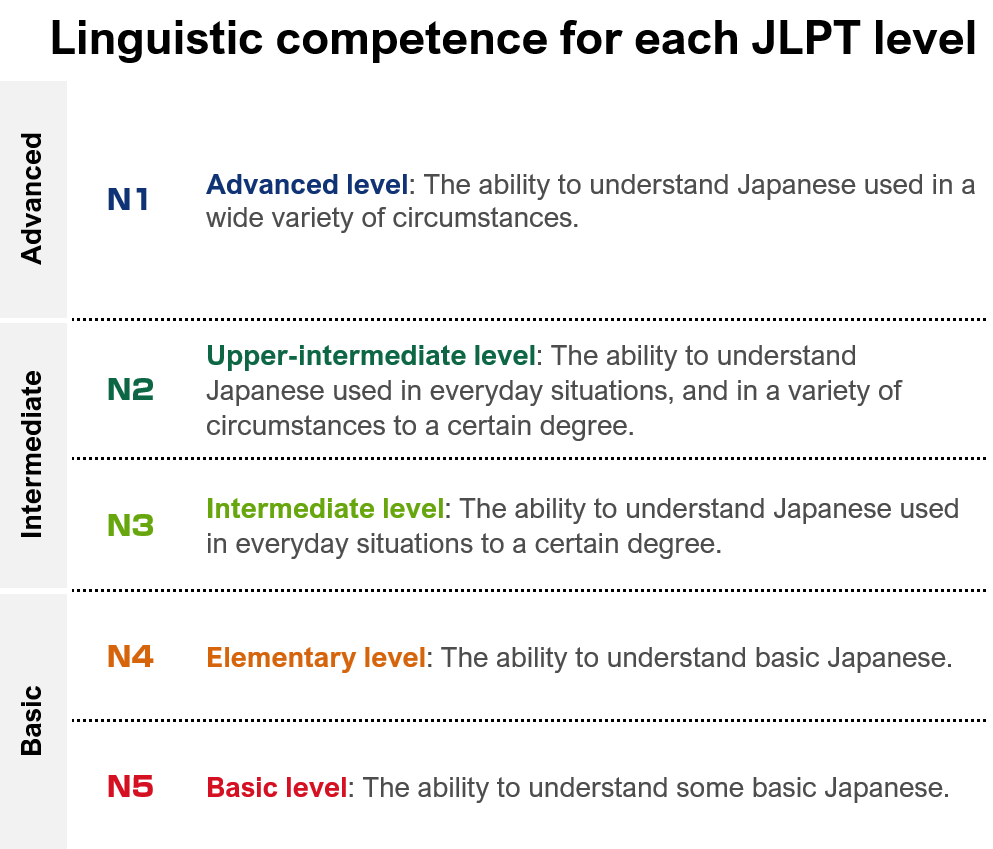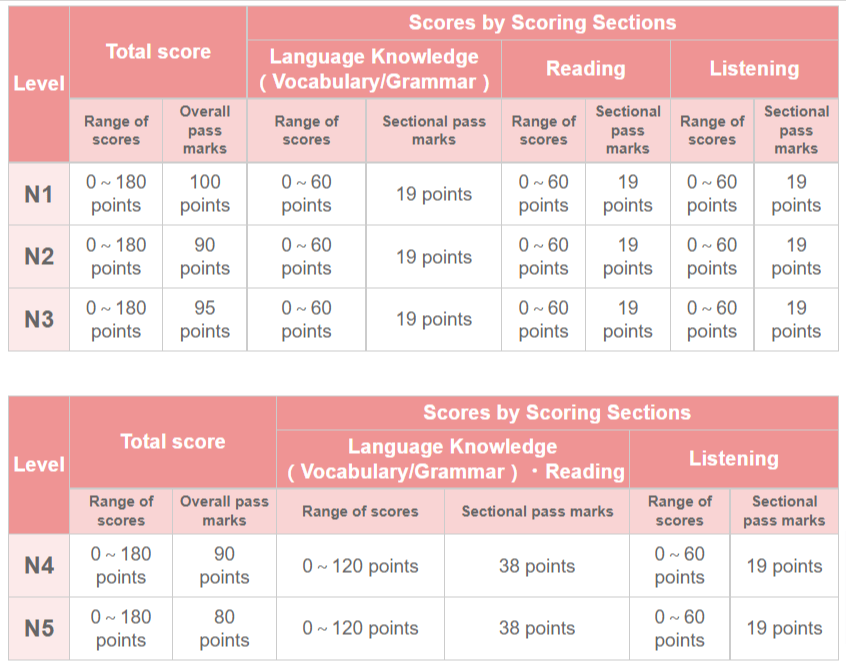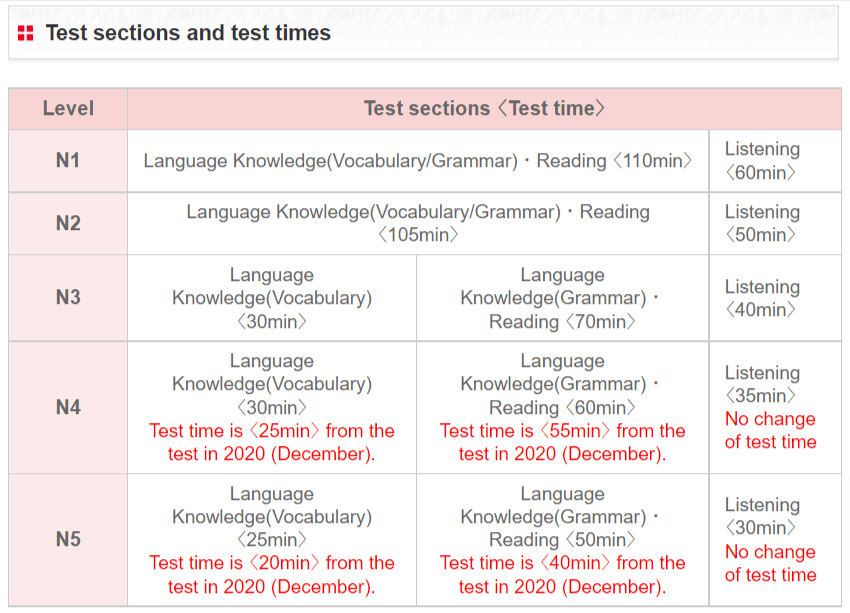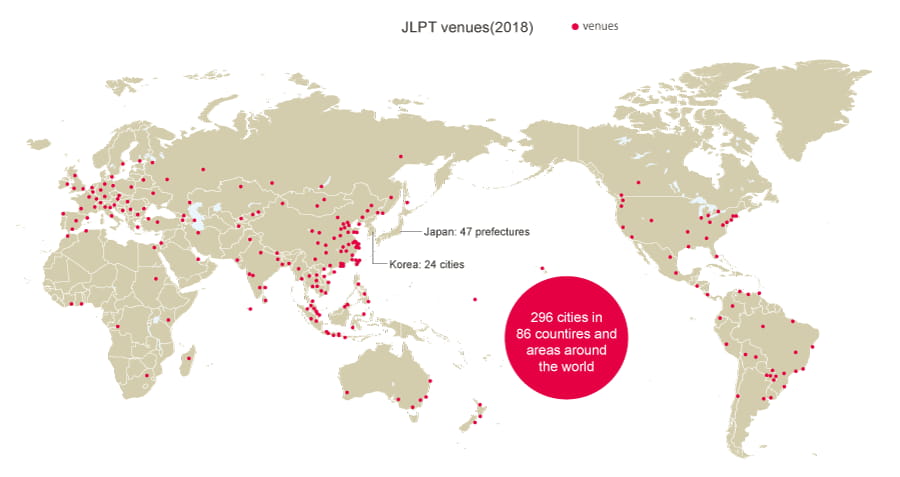
How well do you speak Japanese? Take the 2024 JLPT, a Japanese language proficiency test, to get an accurate level.

You do not necessarily need a JLPT test if your reasons to study Japanese are travel, cultural aspects, or hobbies.
But what if your goal is to get jobs in Japan or employment requires Japanese? Maybe, higher studies in Japan and some academic plan?
Perhaps you just want to track your progress and have an end goal like N3 or N5?
In that case, you might need proof of Japanese competency through a score and an official certificate.
JLPT will be invaluable for personal and professional growth if you fall into this category. This also helps determine your language ability, and you earn a globally recognized international certificate.
Whatever the reason, I highly recommend the JLPT if you want to validate your Japanese skills.
Here, I will provide all the authentic information you need about the JLPT exams.
The guide covers benefits, fees, dates, test centers, exam structure, question format, 2024 registration process, marking system, how to prepare, and much more.

JLPT is the acronym for Japanese-Language Proficiency Test. It was created in 1984 in Japan to assess and certify Japanese language skills.
JLPT aims to verify the Japanese ability of non-native speakers through a reliable and standard assessment.
It measures the candidate’s Japanese knowledge through writing, reading comprehension, listening, grammar, and vocabulary. The test lasts for 1.5 to 3 hours, depending on the level.
JEES (Japan Educational Exchanges and Services) administers the exam in Japan. In contrast, JF (Japan Foundation) carries out overseas tests with the assistance of local institutions.
The JLPT is the most widely recognized test for Japanese language certification.
Nearly all businesses, educational institutions, and governments trust and accept it. The test is designed for non-native speakers.
There are many clear benefits of JLPT.
Japan is a monolingual country. As a result, a powerful command of the language is essential for most jobs related to Japanese. So, it plays a substantial role in finding employment there.
JLPT can add value to your profile if you plan to study, work, or travel to Japan. For example, if you have JLPT, it can enhance your chances of getting hired as an English teacher in Japan.
It is helpful if you apply to Japanese universities or companies. Most ask for a certain JLPT level, ranging from N3 to N1.
Do you want to work as a nurse, caregiver, doctor, or in the medical field? Then, N1 is often needed to take Japan’s national exams for nurses and medical practitioners.
You’ll get 15 and 10 points under the government’s “point-based preferential immigration treatment” system if you pass N2 and N1. Your application gets priority at immigration if you get 70 points or more.
This certification increases your chances of getting scholarships. And also visas and permanent residency in Japan.
Suppose you meet JASSO’s language specifications (N2/200 points in EJU/CEFR B2). Then, you get priority over scholarships for those without a JLPT certificate.
Besides known health benefits, you become more confident when you know your exact Japanese ability. It also confirms your understanding and motivates you to do better.

There are no specific requirements or guidelines.
If you don’t speak Japanese as your first language, you can take the JLPT test to determine your current level. The test is open to Japanese citizens as well, with some conditions.
There is no age limit. So, no matter your age, you can take the test.
The Japanese proficiency test (JLPT) is the most famous Japanese fluency test. It is for non-natives and is conducted worldwide.
The JLPT used to have four levels, 1-4. But, in 2010, they changed the composition by adding a fifth level.
Today, there are five test levels (N1, N2, N3, N4, and N5), from N5 for beginners to N1 for advanced students. Level 1 is the most difficult, while Level 5 is the easiest.

There are 180 points on the JLPT test.
They divided the test questions for N1 to N3 into three sections. (i) Vocabulary and Grammar, (ii) Reading, and (iii) Listening.
The N4 and N5 have only two subgroups: (i) Vocabulary and Grammar, (ii) Reading, and (iii) Listening.
N4 and N5 cover basic knowledge of Japanese, primarily what they teach in class. That would mean you can read Hiragana, Katakana, and 100 to 300 Kanji characters.
The N1 and N2 assessments assess advanced Japanese used in various everyday situations. About 2500 Kanji and over 10,000 words are required for N1.

N3 is the intermediate level between N4 and N2.
You must meet two mandatory criteria to qualify:
These tests require a score of 19/60 or 38/120.

One weakness of the JLPT is the absence of a speaking section. This is because answers may differ and must be graded manually.
JLPT is entirely a multiple-choice test. On the computer-scored answer sheet, you will find MCQs. There are four choices, but sometimes listening questions have only three.
Register two to three months in advance if you want to take the test. For exact dates, check the official website or local test center.
During the registration period, you can register by email or online.
Visit a center near you. Carry a passport-sized photograph, registration fee, and photo identity card. Afterward, complete the entire application form.
They conduct the exam twice a year, in July and December, both in and outside Japan. But in some countries, they offer the test only once a year.
For the July exam, applications open from early March until late April. And for December, the process starts from early August until late September.
But this differs as to available seats and centers. So, get in touch with your nearest center.
In the USA, for instance, the test is available on the first Sunday of December. But you can take it twice a year in India (July and December).
In 2024, the JLPT tests will be held on Sunday, 7th July 2024, and Sunday, 1st December 2024.
There are two shifts in the tests. In the morning, 10:00 am to 12:00 noon, and in the afternoon, 2:00 to 5:00 pm.

Visit the test center websites for more information. Also, on the JLPT site, you’ll find all the latest testing locations and when you can take the exam.
Usually, JLPT scores and results are available within two months of the test date.
They traditionally announce the results of tests conducted in July and December in the last week of August and January of the following year.
Examinees at each level receive a Score Report. Besides, the successful candidates receive a “Certificate of Proficiency.”
As opposed to Spanish SIELE, Korean TOPIK, or French TCF Canada scores, JLPT scores never expire. So, once you pass, your score and certificate have validity for life.
Certain educational institutions and companies, however, have their own policies.
For example, some organizations only accept certifications from the past two to five years. In general, it does not matter when you take the test.
There are many places across the globe where you can take the JLPT exam.
Japan has 47 testing centers, while overseas test centers are located in 249 cities in 85 countries. The number of candidates reached 1 million in 2017.

Currently, India has 8 JLPT test centers – Bengaluru, Chennai, Kolkata, Mumbai, New Delhi, Pune, Santiniketan (West Bengal), and Salem (Tamil Nadu).
There are several authorized testing centers in the United States. For example, Atlanta (GA), Los Angeles (CA), Chicago (IL), Washington, DC, Philadelphia (PA), Fayetteville (AR), Honolulu, HI, Honolulu, HI, etc.
You can view the entire list of the latest test centers in the USA on the AAJT website.
The cost of taking the JLPT test varies depending on the country and your target level.
The cost is minimal compared to other language tests, such as CELI, DELF, TestDaF, HSK, and DELE.
In the USA, the price is roughly US $100. In contrast, the cost ranges between ₹ 1000 to 1600 in India and ₱1,100 to ₱1,500 in the Philippines.
Likewise, the fee is between €70 to €100 in Europe. You can take the test for €75 in Belgium, €90 in Germany, and £100 in England.
Patience, passion, and practice are essential to your success in JLPT.
Your first priority should be to build your vocabulary. If you have already mastered Hiragana and Katakana, your next step should be to study Kanji. Over time, you can increase the number of Kanji you know.
As you advance, you will improve your reading skills, grammar, and listening comprehension. The combination of these skills will make you sound more natural.
On the official website, you will find sample papers with answers, reference books, and supporting study materials.
The Internet offers a variety of tools for this purpose.
You can, for example, use Memrise, Busuu, Duolingo, LMSs, audio podcasts, and e-books to learn languages. You can also try video apps like YouTube, Vimeo, Lingopie to learn Japanese through J-Movies.
You can use these online tools as a starting point, not an end. Sadly, Japanese is a complex language, and mastering it takes time.
I highly recommend taking Japanese lessons or enrolling in a Japanese course in your area. There are many options for Japanese studies worldwide because of the growing demand.

This course will bridge the gap between your JLPT preparation and conversational Japanese. Plus, it will help you strengthen your knowledge before the test.
You can also read the cultural aspects since you will not fully understand Japanese unless you are familiar with the country.
As a Japanese learner, you may want to know your exact level, challenge yourself, and check your current skills.
Perhaps you want to improve your Japanese for professional reasons. Or you may need a high score to apply for a visa in Japan.
Whatever motivation you may have, JLPT can be an excellent value addition to your CV to edge out your competitors. It is a worthwhile endeavor to further your career, academic, and personal goals.
Depending on which level you pass, you can show potential interviewers that you are fluent. Since it’s a tough test, getting certified as a Japanese learner is worth it.
The benefits vary from one person to another. But overall, the advantages far outweigh any drawbacks it may have. So, consider taking the JLPT test if you’ve been studying Japanese for a while.
Do you have any questions you would like me to answer? Feel free to share your thoughts below!
Share your loveI’m a linguist, lifelong learner, educator, blogger, and fun-loving guy. I write at studyfrenchspanish.com, languagenext.com, joyofkorean.com, joyofchinese.com, joyofjapanese.com.